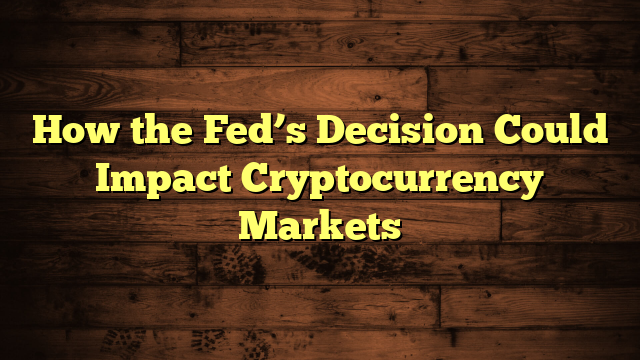How the Fed’s Decision Could Impact Cryptocurrency Markets
The cryptocurrency market, known for its volatility and speculative behavior, remains highly sensitive to macroeconomic factors—particularly decisions made by the U.S. Federal Reserve. As investors closely watch each move the Fed makes regarding interest rates and monetary policy, the potential ripple effects on digital assets like Bitcoin, Ethereum, and altcoins can be significant. This post explores the relationship between the Federal Reserve’s monetary policy and cryptocurrency prices, offering insights into what crypto investors might expect in response to future announcements.
Understanding the Fed’s Role in the Economy
The Federal Reserve, or “the Fed,” is the central bank of the United States and is primarily responsible for managing inflation and stabilizing employment through tools such as interest rates and asset purchases. When inflation rises, the Fed may increase interest rates to help cool down the economy. Conversely, when economic growth lags, the Fed tends to lower rates or implement quantitative easing (QE) to stimulate borrowing and investing.
But how do these actions impact the cryptocurrency market? To understand that, let’s look at the fundamental interplay between traditional financial policy and crypto market behavior.
Interest Rate Hikes and Crypto Volatility
In response to rising inflation, the Fed has in recent months favored rate hikes. These actions aim to tame inflation by making borrowing more expensive and decreasing excess liquidity. The result is a chain reaction that affects all financial markets—including crypto:
- Reduced liquidity in the market: Higher interest rates mean tighter financial conditions, translating into less disposable income and fewer investments in risky assets like cryptocurrencies.
- Decreased risk appetite: Institutional and retail investors alike tend to pull back from more volatile markets, including crypto, when risk-free interest yields from government bonds become more attractive.
- Price corrections: During rate-hike periods, Bitcoin and other cryptocurrencies often experience notable pullbacks, reflecting investors’ cautious sentiment.
Fed Pauses or Rate Cuts Could Spur Bullish Momentum
Conversely, any move by the Fed to hold off further interest rate hikes or to cut rates can be seen by the crypto community as a green light. Here’s why:
- More capital flows into risk assets: Lower interest rates increase investor appetite for alternative investments, including digital currencies.
- Weaker dollar strength: A more dovish Fed results in a softer U.S. dollar, which historically correlates with stronger cryptocurrency performance.
- Rebound in tech and growth sectors: Since the crypto market often moves in tandem with tech stocks, an easing policy bodes well for both sectors.
These dynamics mirror historical periods where Bitcoin and Ethereum rallied in response to looser monetary conditions, particularly during the pandemic-induced quantitative easing era.
Institutional Adoption Hinges on Monetary Policy
An often overlooked yet critical element of the Fed’s influence on crypto involves institutional investors. As hedge funds, family offices, and even pension funds begin to diversify into digital assets, their strategies are tightly correlated with broader macroeconomic conditions.
- Higher rates may delay adoption: Institutions may view crypto as a high-risk, high-reward wager—one that becomes less attractive compared to stable yields from interest-earning products like Treasury bonds.
- Lower rates could accelerate growth: If monetary policy becomes more accommodative, institutions may increase allocations toward crypto as part of a higher-return portfolio strategy.
Furthermore, institutional engagement often signals retail confidence. When large firms show interest in crypto markets, it encourages more mainstream adoption at a faster pace.
What Will the Fed Likely Do Next?
At the time of writing, analysts and economists remain divided on the Fed’s next steps. Some anticipate a pause in rate increases, as inflation data begins to cool. Others expect at least one more hike before 2024, especially if labor markets remain robust and inflation flares again.
Here’s what’s currently influencing the Fed’s outlook:
- Core inflation remains above the 2% target, keeping policymakers cautious.
- Employment remains strong, suggesting the economy can absorb higher borrowing costs for longer.
- Global economic pressures, including energy prices and geopolitical risks, make projections more uncertain.
Market Reactions: A Forecast for Crypto
Based on potential scenarios, below are speculative reactions the crypto market might have to the Fed’s near-term decisions:
- If the Fed pauses: Expect a potential crypto rally, particularly in Bitcoin, which continues to be viewed as “digital gold.” Altcoins may follow, led by Ethereum.
- If the Fed hikes again: Short-term downside in the crypto market is likely, though long-term holders may view dips as buying opportunities.
- If the Fed signals dovish policy for 2024: That could set the stage for a full-scale bull run, especially if institutional demand surges in a low-rate environment.
How Crypto Investors Can Prepare
Given the ongoing uncertainty and the Fed’s pivotal role, crypto investors would do well to adopt a strategic and diversified approach.
Key Tips for Navigating Fed-Driven Volatility:
- Monitor Fed announcements closely: Be aware of FOMC meeting schedules and interest rate forecasts.
- Avoid over-leveraged positions: Interest rate volatility can cause sharp price swings—especially in altcoins.
- Hold a diversified portfolio: Complement crypto holdings with less volatile assets to hedge risk.
- Consider stablecoins: Using stablecoins as liquidity during volatile periods can offer protection and flexibility.
For long-term believers in blockchain technology, Federal Reserve decisions are mainly short- to medium-term headwinds or tailwinds. They don’t change the underlying fundamentals—including growing user adoption, DeFi innovation, and global acceptance.
Conclusion
The U.S. Federal Reserve’s monetary policy deeply impacts how investors allocate capital across all asset classes—even in decentralized spheres like cryptocurrency. Whether hiking, pausing, or cutting interest rates, the Fed’s decisions influence liquidity, investor sentiment, and adoption trends in the crypto space.
For investors and enthusiasts alike, understanding the Fed’s impact on the crypto market can provide a strategic edge. As the macro landscape continues to evolve, staying informed and adaptable is the key to thriving through the cycles of volatility—and capitalizing on the next opportunity that crypto has to offer.
Keep an eye on the Fed… because the crypto markets definitely are.




